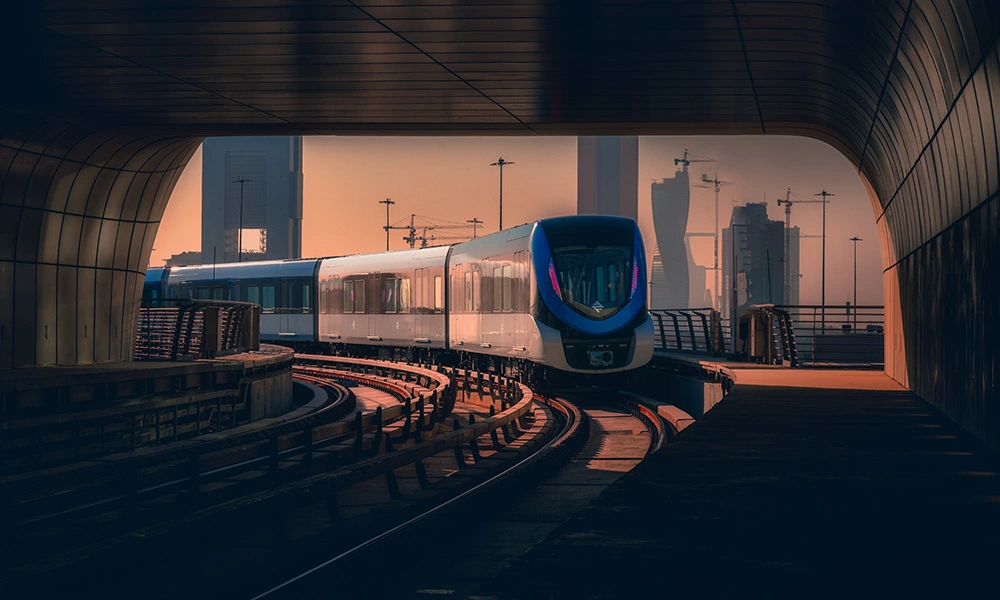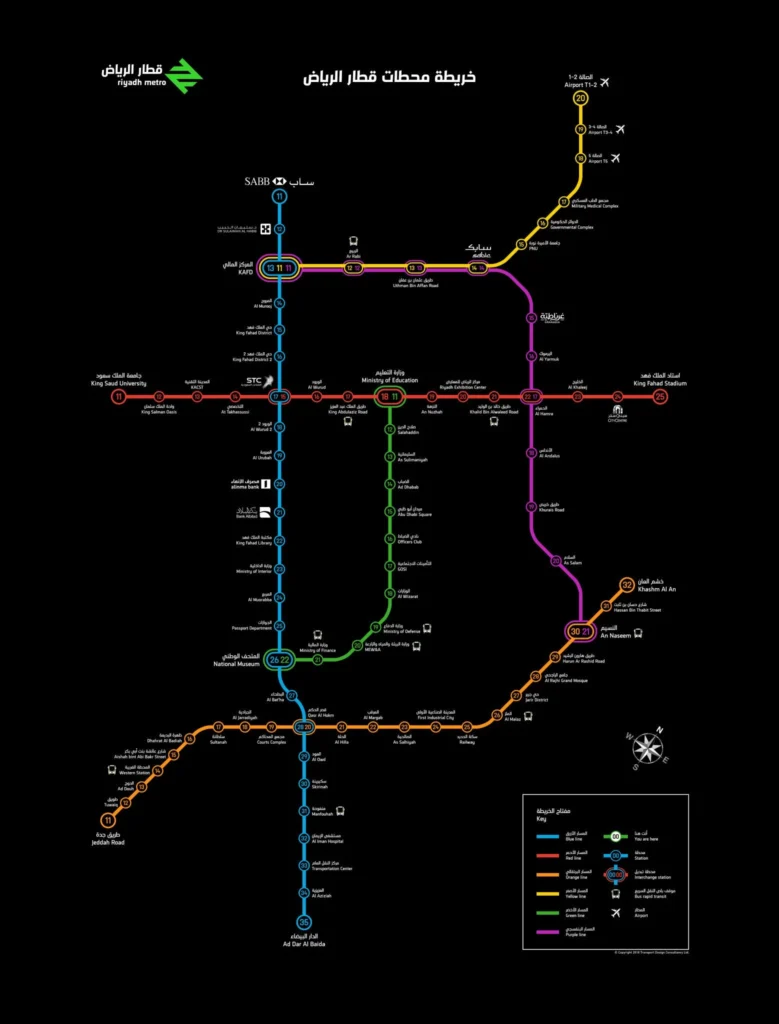metro line riyadh
Metro Line Riyadh
The Riyadh Metro, a cornerstone of the King Abdulaziz Public Transport Project, transforms Saudi Arabia’s capital. Costing $22.5 billion, it spans 176 kilometers with six lines and 85 stations. It carries up to 3.6 million passengers daily, easing traffic in a bustling city. The metro cuts 250,000 car trips daily, boosting sustainable transport for Riyadh’s growing population, set to hit 15 million by 2030. It connects key districts, from business hubs to cultural landmarks, with iconic metro line riyadh stations like KAFD. The system integrates with 80 bus rapid transit routes and 25 park-and-ride lots, ensuring seamless urban mobility solutions.

Riyadh Metro Lines
Launched December 1, 2024, this 176 km driverless network is the world’s longest, boasting 85 stations. The metro cuts traffic jams, saves fuel, and powers a city set to grow to 15 million by 2030. From sleek trains to iconic stops like the King Abdullah Financial District Station, it’s transforming urban mobility.
The Heart of Riyadh’s Mobility
The Metro line riyadh, a cornerstone of the King Abdulaziz Public Transport Project, transforms Saudi Arabia’s capital. Costing $22.5 billion, it spans 176 kilometers with six lines and 85 stations. It carries up to 3.6 million passengers daily, easing traffic in a bustling city. The metro cuts 250,000 car trips daily, boosting sustainable transport for Riyadh’s growing population, set to hit 15 million by 2030. It connects key districts, from business hubs to cultural landmarks, with iconic Metro line riyadh stations like KAFD. The system integrates with 80 bus rapid transit routes and 25 park-and-ride lots, ensuring seamless urban mobility solutions.
The Six Lines: Mapping Riyadh’s Future
The Metro line riyadh six color-coded lines connect the capital’s heart, powering urban mobility with driverless metro technology. Spanning 176 kilometers, these lines link bustling districts, cultural hubs, and business centers. Here’s a look at each line, built to transform travel for Riyadh’s residents, tourists, and growing population.
Line 1 (Blue)
Runs 36.7 km north-south from Al-Olaya to Al-Hayer. With 22 stations, it includes the iconic King Abdullah Financial District Station, designed by Zaha Hadid.
Line 2 (Red)
Stretches 25.3 km east-west, connecting King Saud University to King Fahd Sports City. Its 14 stations serve students and sports fans, offering fast citywide access.
Line 3 (Orange)
The longest at 41.1 km, links Jeddah Road to Prince Saad. Fully opened January 5, 2025, its 20 stations, like Harun Al Rashid, boost east-west travel.
Line 4 (Yellow)
Covers 30 km along King Khalid International Airport Road. Opened December 1, 2024, it’s a lifeline for travelers and airport workers.
Line 5 (Green)
Spans 24.2 km along King Abdulaziz Road. Opened December 15, 2024, it features the National Museum Station, a cultural gem for tourists.
Line 6 (Purple)
Runs 30 km along Abdulrahman bin Auf Road. Launched December 1, 2024, it connects growing neighborhoods with ease.
| Line | Color | Length (km) | Stations | Key Stops | Opened |
| 1 | Blue | 36.7 | 22 | KAFD Station | Dec 1, 2024 |
| 2 | Red | 25.3 | 14 | King Saud University | Dec 15, 2024 |
| 3 | Orange | 41.1 | 20 | Harun Al Rashid | Jan 5, 2025 |
| 4 | Yellow | 30 | Varies | Airport Road | Dec 1, 2024 |
| 5 | Green | 24.2 | Varies | National Museum Station | Dec 15, 2024 |
| 6 | Purple | 30 | Varies | Abdulrahman bin Auf | Dec 1, 2024 |
Metro Line Riyadh Technologies
The Metro line riyadh blends stunning design with cutting-edge technology, redefining urban travel. Its iconic stations shine as architectural gems. The King Abdullah Financial District Station, crafted by Zaha Hadid, features flowing, desert-inspired curves. Qasr Al Hokm Downtown Station captures Saudi heritage with modern flair. The National Museum Station, a cultural hub, draws tourists with its unique mountain-like design. Western Station serves as a key transit point for commuters.
Driverless metro technology powers the system. Alstom Metropolis trains offer ergonomic seating, LED lighting, and air-conditioning for comfort. Siemens Inspiro trains add sleek design and efficiency. Regenerative braking saves energy, making rides smoother and greener. Solar cells generate 20% of the metro’s electricity, cutting 12.5 million tons of CO2 yearly. This boosts sustainable transport in Saudi Arabia.
Accessibility keeps everyone moving. Step-free access helps people with disabilities. Free Wi-Fi and real-time updates via the Darb app simplify trips. Riders plan journeys easily, from KAFD to Qasr Al Hokm. The metro’s tech and design make it a global leader, blending innovation with Metro line riyadh vision for a smarter future.

How to Ride the Riyadh Metro
Riding the Riyadh Metro is simple and affordable. Tickets cost SAR4 for a two-hour trip. Need more travel? Grab passes from SAR20 for three days to SAR140 for 30 days. The Darb app makes ticketing easy with NFC technology. Download it, load funds, and scan to ride. No cash? No problem!
The metro runs from 6:00 AM to 12:00 AM daily. Trains arrive every 2.5 minutes during peak hours, keeping you moving fast. With 85 stations, you’ll reach places like the National Museum or KAFD Station in minutes.
Connectivity shines with multimodal transport integration. Link your metro ride to 80 bus lines and 3,000 stops citywide. Park-and-ride facilities at 25 locations let you drive, park, and hop on. This setup cuts traffic and saves time.
How to Ride: Step-by-Step
- Download the Darb app from your app store.
- Add funds and get your NFC-enabled ticket.
- Scan at any station, like Qasr Al Hokm.
- Board your train and enjoy the ride!
The Riyadh Metro makes city travel a breeze. Plan your trip at riyadhmetro.sa or on the Darb app today!
Transforming Riyadh’s Landscape
he Riyadh Metro reshapes the capital, driving economic, environmental, and social gains. It aligns with Saudi Arabia’s Vision 2030, boosting growth and sustainability. The project created 15,000 jobs, from construction to operations, fueling local economies. It supports Vision 2030’s push to diversify beyond oil, attracting businesses and investors. New commercial hubs near metro stations spark real estate and retail growth.
Environmentally, the metro saves 400,000 liters of fuel daily, cutting emissions and easing traffic. It reduces congestion by 250,000 car trips daily, making Riyadh cleaner and calmer. Sustainable transport in Saudi Arabia thrives with the metro’s electric trains and solar-powered stations, which generate 20% of their energy.
Socially, urban mobility solutions connect people to universities, hospitals, and cultural spots like the National Museum. Residents like Aisha, a student, now reach King Saud University faster. Tourists explore historic sites with ease, boosting community ties. In its first week of December 2024, 1.9 million passengers rode the metro, showing strong public trust, as shared by @RiyadhTransport on X.
Challenges and Triumphs
- The Metro line riyadh, a key part of the King Abdulaziz Public Transport Project, faced hurdles but achieved greatness. Construction delays, sparked by disputes and the COVID-19 pandemic, slowed progress. By 2022, teams resolved these setbacks. In 2017, allegations of contract misuse surfaced against a former official. These issues, though, never derailed the vision.
- Triumphs shine brighter. The metro earned global praise as the world’s longest driverless network, spanning 176 km. Its phased openings—Lines 1, 4, and 6 in December 2024, then Lines 2, 5, and 3 by January 2025—ran smoothly. Three consortiums led the charge: BACS built Lines 1 and 2, ANM tackled Line 3, and FAST delivered Lines 4, 5, and 6. They used advanced tools like Full Span Launching Method (FSLM) and tunnel boring machines (TBMs) to conquer tough terrain.
- These feats showcase engineering excellence and Saudi Arabia’s bold ambition. The metro now serves millions, proving its success.
Exploring the Riyadh Metro Routes
The Metro line riyadh eyes a bold future with Line 7, a 65 km expansion linking key hubs. It connects Qiddiya Entertainment City, Diriyah Gate, King Salman Park, New Murabba, and King Khalid International Airport. With 19 stations—14 underground, five elevated—it’s set to boost urban mobility. Bidding for Line 7, part of the Line 7 Metro line riyadh expansion, closed March 10, 2025, with top firms like Alstom and Siemens competing. More expansions target Khuzam, Badr, and Shafa suburbs, plus Fursan and western King Saud University, to serve growing neighborhoods.
These plans fuel Saudi Arabia’s Vision 2030, driving smart city initiatives in Riyadh. The metro aims to support a population boom to 15 million by 2030, making the city a global economic hub. Line 7 alone, backed by a $21 billion investment, links entertainment, culture, and travel hubs, creating a connected capital. The metro’s growth promises a greener, smarter Riyadh.
Frequently Asked Questions
1. What is Metro Line Riyadh?
Metro Line Riyadh is part of the Riyadh Metro network, a modern transportation system designed to connect key areas of the city efficiently and reduce traffic congestion.
2. How many lines are in the Riyadh Metro?
The Riyadh Metro has six main lines, each identified by a color and serving different parts of the city, from the airport area to residential and commercial districts.
3. Which routes does Metro Line Riyadh cover?
Metro Line Riyadh connects major landmarks, business zones, and residential areas. Stations are strategically located for easy access to shopping centers, offices, and schools.
4. What are the operating hours of Metro Line Riyadh?
Trains typically run from early morning until midnight, offering frequent service throughout the day to accommodate commuters and visitors.
5. How can I check the Metro Line Riyadh schedule?
You can find updated schedules at station information boards and through the official metro app, which provides live train timings and route updates.
6. Are Metro Line Riyadh stations connected to buses or other transport?
Yes, most stations offer integrated connections to buses and park-and-ride facilities, making it easy to continue your journey anywhere in Riyadh.
7. How much does it cost to travel on Metro Line Riyadh?
Ticket prices vary by distance and class, starting from affordable single rides to multi-day passes. Discount options are available for students, seniors, and people with disabilities.
8. Is Metro Line Riyadh fully operational in 2025?
Most lines are operational, with remaining sections opening in phases during 2025 as part of the city’s full metro rollout.
Conclusion
The Metro line Riyadh transforms Saudi Arabia’s capital into a global, sustainable hub. Its 176 km network, with 85 stations, cuts traffic and emissions. Aligned with Saudi Arabia’s Vision 2030, it connects communities, boosts jobs, and supports 15 million residents by 2030. From iconic KAFD Station to Line 7’s bold plans, the metro shapes a smart city. Try the metro today, hop on at Qasr Al Hokm, or explore via the Darb app. The Riyadh Metro isn’t just transport—it’s the heartbeat of a new Riyadh. Join the journey and see the future unfold!
